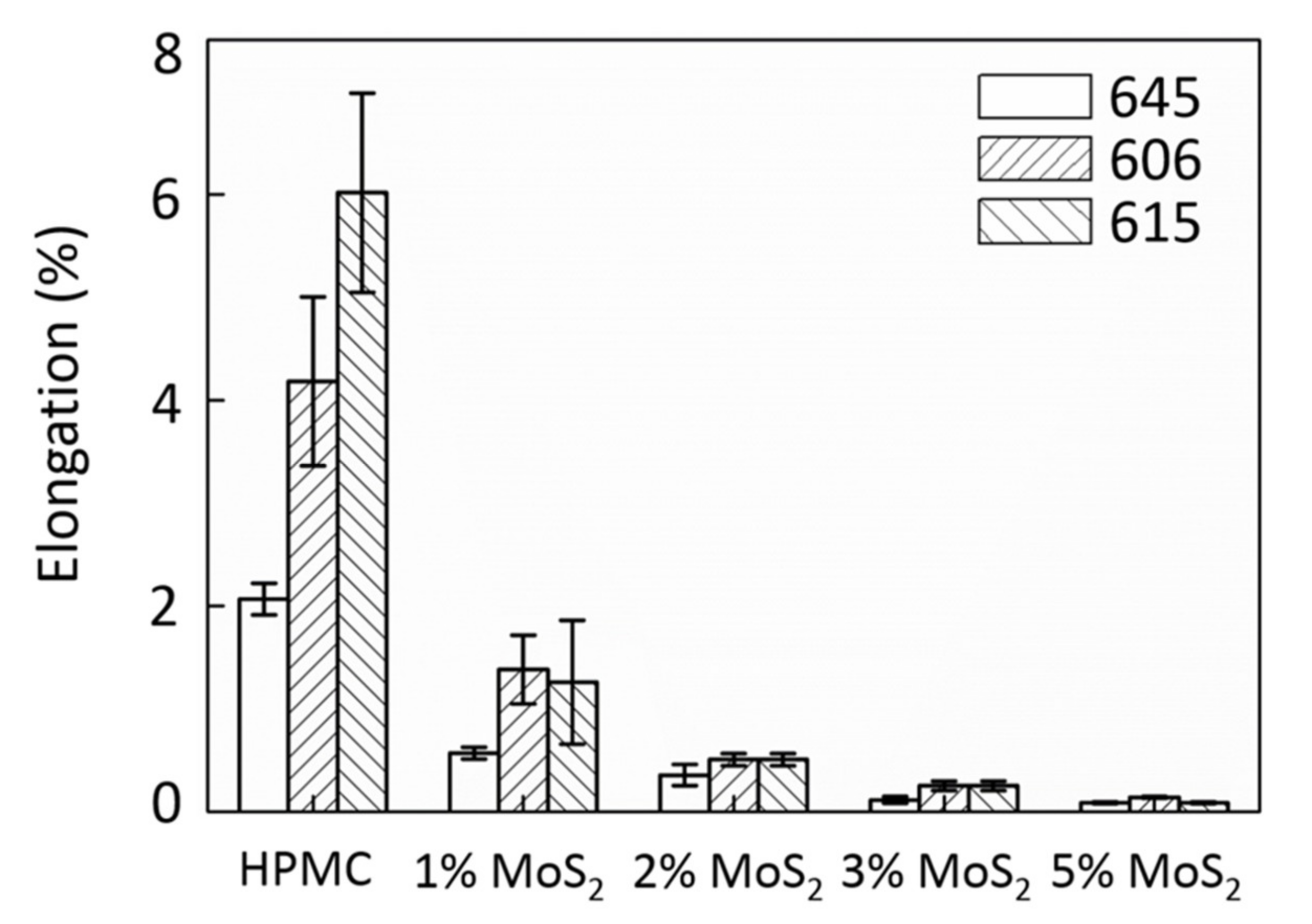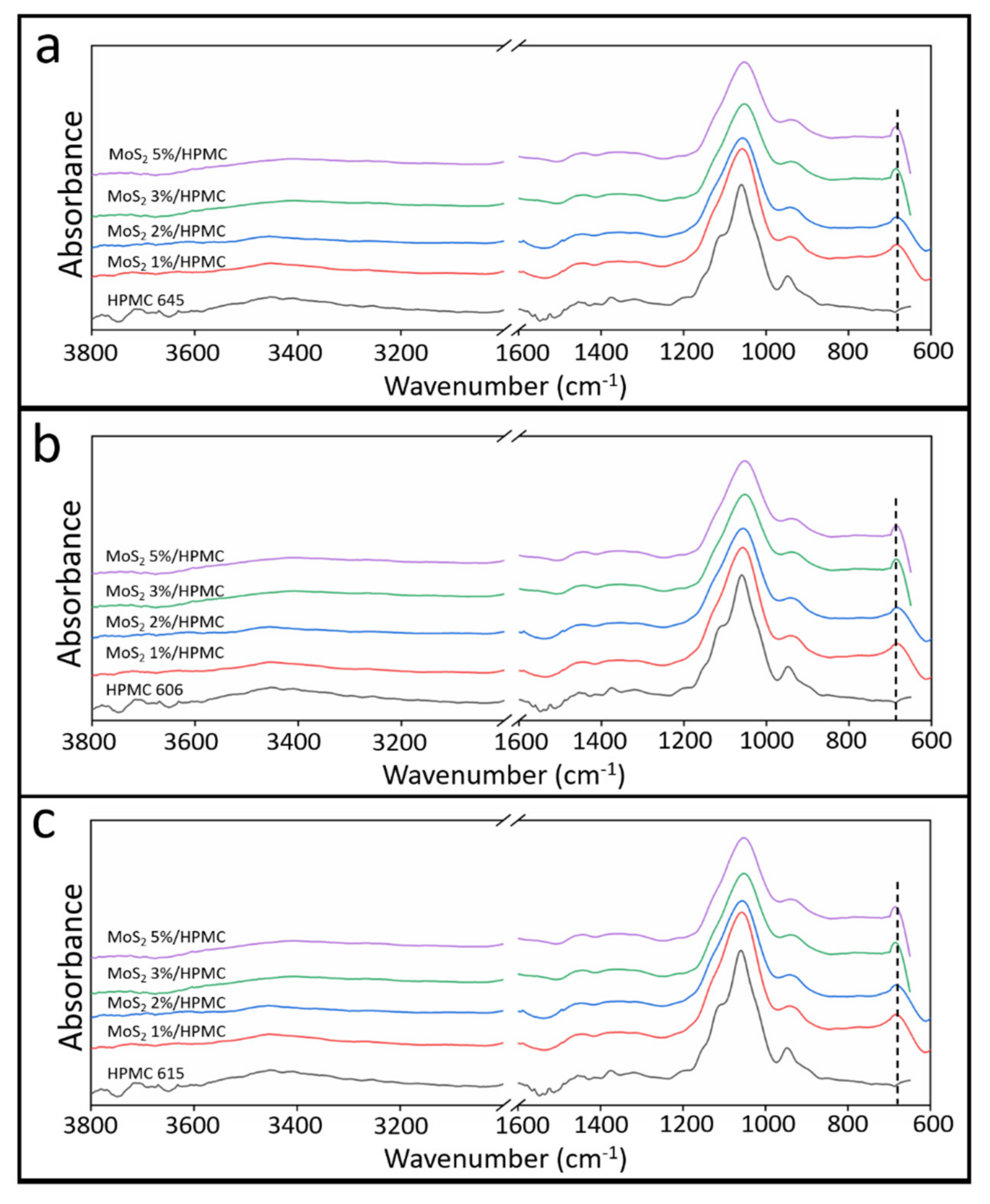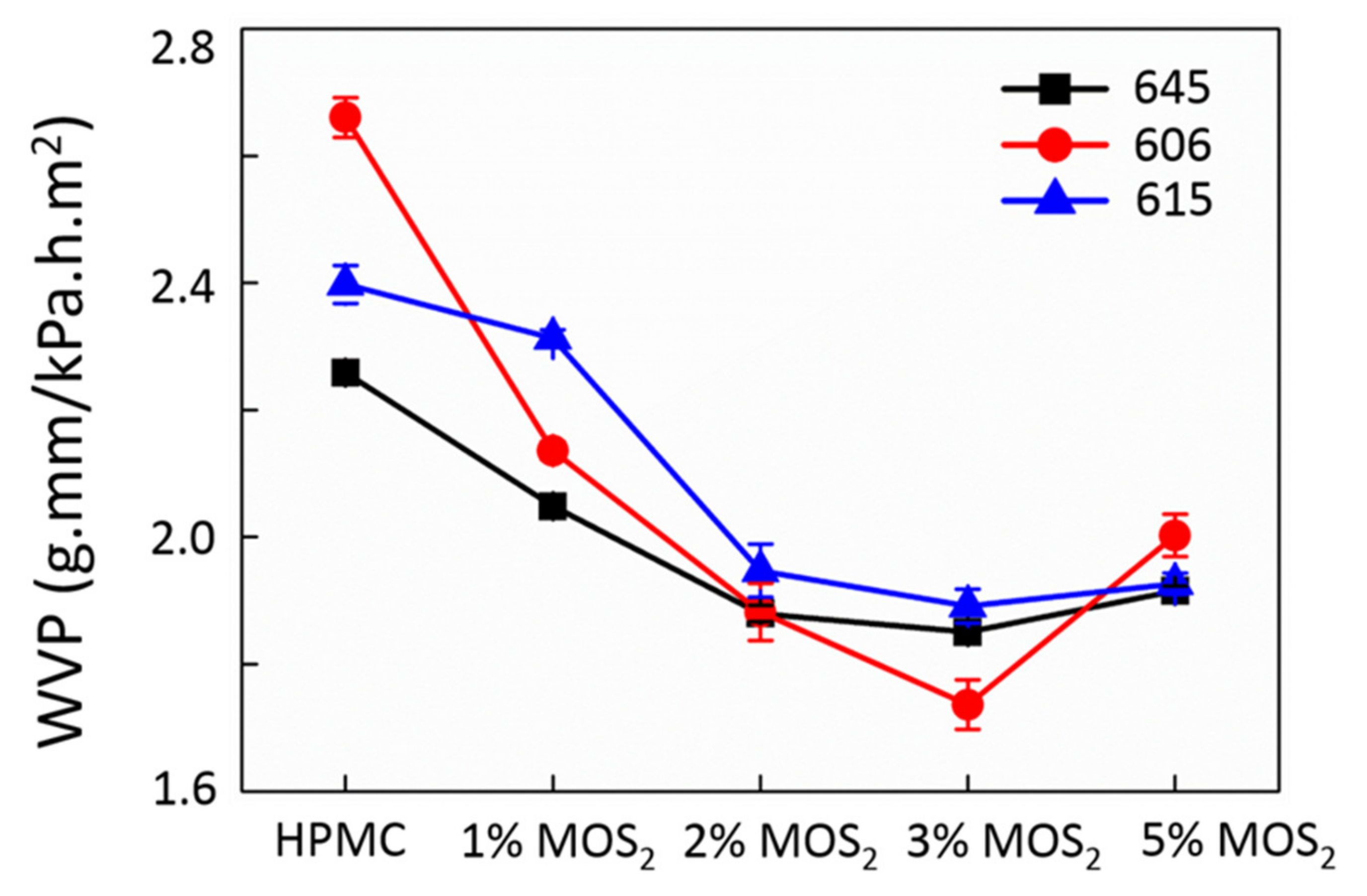Mechanical Properties and Tribological Behavior of MoS2-Enhanced Cellulose-Based Biocomposites for Food Packaging
Abstract
1. Introduction
2. Materials and Methods
2.1. Materials
2.2. Film Preparation
2.3. Determination of Mechanical Properties
2.4. Material Properties Analysis of Composite
2.5. Tribology Performance of MoS2/HPMC Composite Film
2.6. Third-Body Theory
3. Results and Discussion
3.1. Surface Morphology and XRD Analysis of Composite Film
3.2. Mechanical Properties of Composite Films
3.3. ATR–FTIR Spectroscopy
3.4. WVP Analysis
3.5. Tribological Behavior of MoS2/HPMC Composites
3.6. Third-Body Tribological Mechanism
4. Conclusions
Author Contributions
Funding
Institutional Review Board Statement
Informed Consent Statement
Acknowledgments
Conflicts of Interest
References
- Alfei, S.; Marengo, B.; Zuccari, G. Nanotechnology application in food packaging: A plethora of opportunities versus pending risks assessment and public concerns. Food Res. Int. 2020, 109664. [Google Scholar] [CrossRef]
- Alfei, S.; Schito, A.M.; Zuccari, G. Biodegradable and compostable shopping bags under investigation by ftir spectroscopy. Appl. Sci. 2021, 11, 621. [Google Scholar] [CrossRef]
- Mohammadi, M.A.; Ramezani, S.; Hosseini, H.; Mortazavian, A.M.; Hosseini, S.M.; Ghorbani, M. Electrospun antibacterial and antioxidant zein/polylactic acid/hydroxypropyl methylcellulose nanofibers as an active food packaging system. Food Bioproc. Tech. 2021, 1–13. [Google Scholar] [CrossRef]
- Chaiwarit, T.; Kantrong, N.; Sommano, S.R.; Rachtanapun, P.; Junmahasathien, T.; Kumpugdee-Vollrath, M.; Jantrawut, P. Extraction of tropical fruit peels and development of hpmc film containing the extracts as an active antibacterial packaging material. Molecules 2021, 26, 2265. [Google Scholar] [CrossRef] [PubMed]
- Di Filippo, M.F.; Dolci, L.S.; Liccardo, L.; Bigi, A.; Bonvicini, F.; Gentilomi, G.A.; Passerini, N.; Panzavolta, S.; Albertini, B. Cellulose derivatives-snail slime films: New disposable eco-friendly materials for food packaging. Food Hydrocoll. 2021, 111, 106247. [Google Scholar] [CrossRef]
- Priyadarshi, R.; Rhim, J.-W. Chitosan-based biodegradable functional films for food packaging applications. Innov. Food Sci. Emerg. Technol. 2020, 62, 102346. [Google Scholar] [CrossRef]
- Kumar, S.; Mukherjee, A.; Dutta, J. Chitosan based nanocomposite films and coatings: Emerging antimicrobial food packaging alternatives. Trends Food Sci. Technol. 2020, 97, 196–209. [Google Scholar] [CrossRef]
- Yadav, S.; Mehrotra, G.; Dutta, P. Chitosan based zno nanoparticles loaded gallic-acid films for active food packaging. Food Chem. 2021, 334, 127605. [Google Scholar] [CrossRef]
- Strachan, J. Solubility of cellulose in water. Nature 1938, 141, 332–333. [Google Scholar] [CrossRef]
- Shi, S.-C.; Jiang, S.-Z. Influence of graphene/copper hybrid nanoparticle additives on tribological properties of solid cellulose lubricants. Surf. Coat. Technol. 2020, 389, 125655. [Google Scholar] [CrossRef]
- Shi, S.-C.; Huang, T.-F. Self-healing materials for ecotribology. Materials 2017, 10, 91. [Google Scholar] [CrossRef] [PubMed]
- Nosonovsky, M.; Bhushan, B. Green Tribology: Biomimetics, Energy Conservation and Sustainability, 1st ed.; Michael, N., Bharat, B., Eds.; Springer: Berlin, Germany, 2012; Volume 1, pp. 79–104. [Google Scholar]
- Fahs, A.; Brogly, M.; Bistac, S.; Schmitt, M. Hydroxypropyl methylcellulose (hpmc) formulated films: Relevance to adhesion and friction surface properties. Carbohydr. Polym. 2010, 80, 105–114. [Google Scholar] [CrossRef]
- Pei, Y.; Ocelik, V.; De Hosson, J.T.M. Sicp/ti6al4v functionally graded materials produced by laser melt injection. Acta Mater. 2002, 50, 2035–2051. [Google Scholar] [CrossRef]
- Shi, S.-C.; Su, C.-C. Electrochemical behavior of hydroxypropyl methylcellulose acetate succinate as novel biopolymeric anticorrosion coating. Mater. Chem. Phys. 2020, 248, 122929. [Google Scholar] [CrossRef]
- Liu, M.; Zhu, H.; Wang, Y.; Sevencan, C.; Li, B.L. Functionalized mos2-based nanomaterials for cancer phototherapy and other biomedical applications. ACS Mater. Lett. 2021, 3, 462–496. [Google Scholar] [CrossRef]
- Shi, S.-C.; Wu, J.-Y.; Peng, Y.-Q. Transfer layer formation in mos2/hydroxypropyl methylcellulose composite. Wear 2018, 408, 208–213. [Google Scholar] [CrossRef]
- Wrona, M.; Cran, M.J.; Nerín, C.; Bigger, S.W. Development and characterisation of hpmc films containing pla nanoparticles loaded with green tea extract for food packaging applications. Carbohydr. Polym. 2017, 156, 108–117. [Google Scholar] [CrossRef]
- Shi, S.-C.; Peng, Y.-Q. Preparation and tribological studies of stearic acid-modified biopolymer coating. Prog. Org. Coat. 2020, 138, 105304. [Google Scholar] [CrossRef]
- Tagami, T.; Ito, E.; Kida, R.; Hirose, K.; Noda, T.; Ozeki, T. 3d printing of gummy drug formulations composed of gelatin and an hpmc-based hydrogel for pediatric use. Int. J. Pharm. 2021, 594, 120118. [Google Scholar] [CrossRef] [PubMed]
- Yu, J.Y.; Kim, J.A.; Joung, H.J.; Ko, J.A.; Park, H.J. Preparation and characterization of curcumin solid dispersion using hpmc. J. Food Sci. 2020, 85, 3866–3873. [Google Scholar] [CrossRef]
- Malik, G.K.; Mitra, J. Zinc oxide nanoparticle synthesis, characterization, and their effect on mechanical, barrier, and optical properties of hpmc-based edible film. Food BioProc. Tech. 2021, 14, 441–456. [Google Scholar] [CrossRef]
- Shi, S.-C.; Lu, F.-I. Biopolymer green lubricant for sustainable manufacturing. Materials 2016, 9, 338. [Google Scholar] [CrossRef]
- Xu, R.; Wei, N.; Li, Z.; Song, X.; Li, Q.; Sun, K.; Yang, E.; Gong, L.; Sui, Y.; Tian, J. Construction of hierarchical 2d/2d ti3c2/mos2 nanocomposites for high-efficiency solar steam generation. J. Colloid. Interface Sci. 2021, 584, 125–133. [Google Scholar] [CrossRef]
- He, D.; Yang, Y.; Zhou, Y.; Wan, J.; Wang, H.; Fan, X.; Li, Q.; Huang, H. Electricity generation from phase-engineered flexible mos2 nanosheets under moisture. Nano Energy 2021, 81, 105630. [Google Scholar] [CrossRef]
- Subad, R.A.; Akash, T.S.; Bose, P.; Islam, M.M. Engineered defects to modulate fracture strength of single layer mos2: An atomistic study. Physica B Condens. Matter 2020, 592, 412219. [Google Scholar] [CrossRef]
- Shi, S.-C.; Wu, J.-Y.; Huang, T.-F.; Peng, Y.-Q. Improving the tribological performance of biopolymer coating with mos 2 additive. Surf. Coat. Technol. 2016, 303, 250–255. [Google Scholar] [CrossRef]
- Nomura, T.; Moriguchi, H.; Tsuda, K.; Isobe, K.; Ikegaya, A.; Moriyama, K. Material design method for the functionally graded cemented carbide tool. Int. J. Refract. Hard Mater. 1999, 17, 397–404. [Google Scholar] [CrossRef]
- Godet, M. Third-bodies in tribology. Wear 1990, 136, 29–45. [Google Scholar] [CrossRef]
- Godet, M. The third-body approach: A mechanical view of wear. Wear 1984, 100, 437–452. [Google Scholar] [CrossRef]
- Shi, S.-C.; Pek, S.-S. Third-body and dissipation energy in green tribology film. Appl. Sci. 2019, 9, 3787. [Google Scholar] [CrossRef]
- Panitz, J.; Pope, L.; Lyons, J.; Staley, D. The tribological properties of mos2 coatings in vacuum, low relative humidity, and high relative humidity environments. J. Vac. Sci. Technol. A 1988, 6, 1166–1170. [Google Scholar] [CrossRef]
- Hilton, M.R.; Bauer, R.; Didziulis, S.V.; Dugger, M.T.; Keem, J.M.; Scholhamer, J. Structural and tribological studies of mos2 solid lubricant films having tailored metal-multilayer nanostructures. Surf. Coat. Technol. 1992, 53, 13–23. [Google Scholar] [CrossRef]
- Descartes, S.; Berthier, Y. Rheology and flows of solid third bodies: Background and application to an mos 1.6 coating. Wear 2002, 252, 546–556. [Google Scholar] [CrossRef]
- Yamada, K.; Mitsutake, T.; Takayanagi, M.; Kajiyama, T. Mechanical properties and intermolecular interactions in molecular composites composed of wholly aromatic polyamide and poly-(amide-imide). J. Macromol. Sci. Chem. A. 1989, 26, 891–902. [Google Scholar] [CrossRef]
- Wang, H.; Tashiro, K. Reinvestigation of crystal structure and intermolecular interactions of biodegradable poly (3-hydroxybutyrate) α-form and the prediction of its mechanical property. Macromolecules 2016, 49, 581–594. [Google Scholar] [CrossRef]
- Galant, O.; Bae, S.; Silberstein, M.N.; Diesendruck, C.E. Highly stretchable polymers: Mechanical properties improvement by balancing intra-and intermolecular interactions. Adv. Funct. Mater. 2020, 30, 1901806. [Google Scholar] [CrossRef]
- Baiz, C.R.; Błasiak, B.; Bredenbeck, J.; Cho, M.; Choi, J.-H.; Corcelli, S.A.; Dijkstra, A.G.; Feng, C.-J.; Garrett-Roe, S.; Ge, N.-H. Vibrational spectroscopic map, vibrational spectroscopy, and intermolecular interaction. Chem. Rev. 2020, 120, 7152–7218. [Google Scholar] [CrossRef]
- Chen, Z.; Mo, X.; He, C.; Wang, H. Intermolecular interactions in electrospun collagen–chitosan complex nanofibers. Carbohydr. Polym. 2008, 72, 410–418. [Google Scholar] [CrossRef]
- Goudarzi, V.; Shahabi-Ghahfarrokhi, I.; Babaei-Ghazvini, A. Preparation of ecofriendly uv-protective food packaging material by starch/tio2 bio-nanocomposite: Characterization. Int. J. Biol. Macromol. 2017, 95, 306–313. [Google Scholar] [CrossRef]








| Grade | Molecular Weight (g/mol) | Viscosity (mPas) |
|---|---|---|
| HPMC 645 | 20,000 | 4.5 |
| HPMC 606 | 35,600 | 6 |
| HPMC 615 | 60,000 | 15 |
| Material | Degradability | Biofriendly | Light Absorption | Moisture Barrier | Strength | Tribology Properties |
|---|---|---|---|---|---|---|
| HPMC | Good [22] | Good [23] | Bad | Bad | Bad | Bad |
| MoS2 | Bad | Good [16] | Good [24] | Good [25] | Good [26] | Good [27] |
| MoS2 (g) | 0 | 1.03 | 2.06 | 3.09 | 5.15 |
| MoS2 (wt%) | 0 | 1 | 2 | 3 | 5 |
Publisher’s Note: MDPI stays neutral with regard to jurisdictional claims in published maps and institutional affiliations. |
© 2021 by the authors. Licensee MDPI, Basel, Switzerland. This article is an open access article distributed under the terms and conditions of the Creative Commons Attribution (CC BY) license (https://creativecommons.org/licenses/by/4.0/).
Share and Cite
Shi, S.-C.; Mandal, P.K.; Chen, T.-H. Mechanical Properties and Tribological Behavior of MoS2-Enhanced Cellulose-Based Biocomposites for Food Packaging. Polymers 2021, 13, 1838. https://doi.org/10.3390/polym13111838
Shi S-C, Mandal PK, Chen T-H. Mechanical Properties and Tribological Behavior of MoS2-Enhanced Cellulose-Based Biocomposites for Food Packaging. Polymers. 2021; 13(11):1838. https://doi.org/10.3390/polym13111838
Chicago/Turabian StyleShi, Shih-Chen, Pramod Kumar Mandal, and Tao-Hsing Chen. 2021. "Mechanical Properties and Tribological Behavior of MoS2-Enhanced Cellulose-Based Biocomposites for Food Packaging" Polymers 13, no. 11: 1838. https://doi.org/10.3390/polym13111838
APA StyleShi, S.-C., Mandal, P. K., & Chen, T.-H. (2021). Mechanical Properties and Tribological Behavior of MoS2-Enhanced Cellulose-Based Biocomposites for Food Packaging. Polymers, 13(11), 1838. https://doi.org/10.3390/polym13111838








